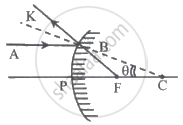Advertisements
Advertisements
प्रश्न
Obtain the equation for resolving the power of the microscope.
उत्तर
- A microscope is used to see the details of the object under observation. The ability of a microscope depends not only in magnifying the object but also in resolving two points on the object separated by a small distance dmin. Smaller the value of dmin better will be the resolving power of the microscope.

Resolving power of microscope
`"r"_0 = (1.22 lambda "v")/"a"` - then the magnification m is,
m = `"r"_0/"d"_"min"`
`"d"_"min" = "r"_0/"m" = (1.22 lambda"v")/"am" = (1.22 lambda "v")/("a"("v"//"u")) = (1.22 lambda"u")/"a"`
[∴ m = v/u]
`"d"_"min" = (1.22 lambda "f")/"a"` [∴ u ≈f]
On the other side,
2 tan β ≈ 2 sin β = `"a"/"f"` ∴ [a = f 2sin β]
`"d"_"min" = (1.22 lambda)/(2 sin beta)` - To further reduce the value of dmin the optical path of the light is increased by immersing the objective of the microscope into a bath containing oil of refractive index n.
`"d"_"min" = (1.22 lambda)/(2"n" sin beta)` - Such an objective is called oil-immersed objective. The term n sin β is called numerical aperture NA.
`"d"_"min" = (1.22 lambda)/(2 ("NA"))`
APPEARS IN
संबंधित प्रश्न
Answer the following question in detail.
What is the limitation in increasing the magnifying powers of a simple microscope?
Why is oil-immersed objective preferred in a microscope?
What are the advantages and disadvantages of using a reflecting telescope?
What is the use of an erecting lens in a terrestrial telescope?
What are the uses of spectrometer?
What is myopia?
What is hypermetropia?
What is astigmatism? What is its remedy?
Mention different parts of the spectrometer.
Explain the preliminary adjustments of the spectrometer.
Explain the experimental determination of the material of the prism using a spectrometer.
There are four convex lenses L1, L2, L3 and L4 of focal length 2, 4, 6 and 8 cm, respectively. Two of these lenses from a telescope of length 10 cm and magnifying power 4. The objective and eye lenses are respectively
A simple microscope is used to see the object first in blue light and then in red light. Due to the change from blue to red light, what is the effect on its magnifying power?
The speed of light in media 'A' and 'B' are 2.0 × 1010 cm/s and 1.5 × 1010 cm/s respectively. A ray of light enters from medium B to A at an incident angle 'θ'. If the ray suffers total internal reflection, then ______.
An object viewed from a near point distance of 25 cm, using a microscopic lens with magnification '6', gives an unresolved image. A resolved image is observed at infinite distance with a total magnification double the earlier using an eyepiece along with the given lens and a tube of length 0.6 m, if the focal length of the eyepiece is equal to ______ cm.
An observer looks at a distant tree of height 10 m with a telescope of magnifying power of 20. To the observer the tree appears:
In the adjoining figure, AB represents the incident ray, and BK is the reflected ray. If angle BCF = θ, then ∠BFP is given by ______.

A camera objective has an aperture diameter of d. If the aperture is reduced to diameter d/2, the exposure time under identical conditions of light should be made ______.
